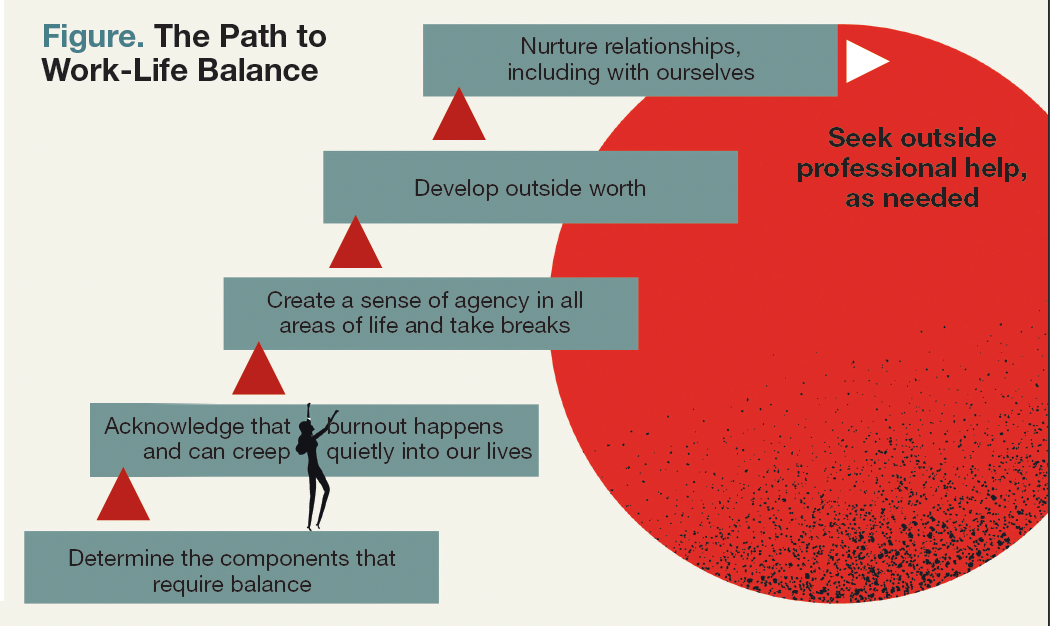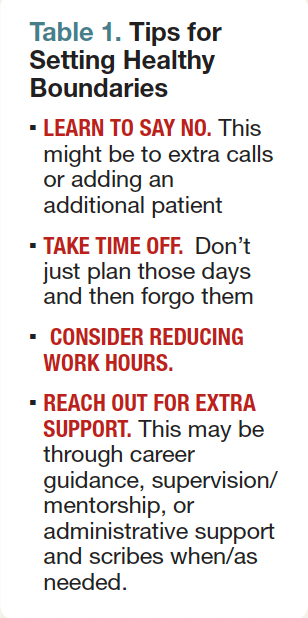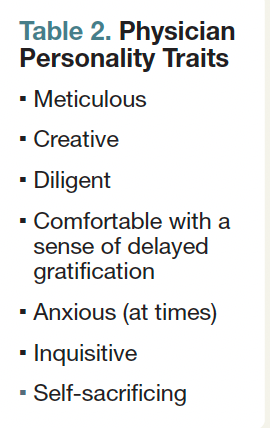Also In This Special Report
Physician, Heal Thyself: An Introduction
H. Steven Moffic, MD
Understanding and Addressing Physician Substance Use and Misuse
Peter Grinspoon, MD
Publication
Article
Psychiatric Times
Author(s):
jozefmicic/AdobeStock

SPECIAL REPORT: PHYSICIAN WELLNESS PART 1
Although much attention has been paid to the idea of work-life balance, many of us were never taught or formally trained as to what that constitutes, how to achieve it, or how to maintain it. Moreover, prioritizing any sort of balance in our current medical culture often feels antithetical to the dedication to medicine that is expected of us.
Physician, Heal Thyself: An Introduction
H. Steven Moffic, MD
Understanding and Addressing Physician Substance Use and Misuse
Peter Grinspoon, MD
We are often of the mind-set that dedication to our profession requires extraordinary sacrifices—to our health, time with children and family, and anything else outside of work. Yet overworking—especially in invalidating, exhausting, or even downright toxic environments—without the ability to refuel by tapping into enriching or meaningful personal areas of life is a fast track to burnout. And so many of us do this exact thing, tirelessly.
In addition, most of us do not have the ability to clock in and out and leave work completely behind. In fact, many colleagues report they bring work home, often finding themselves charting late into the night. Or they bring psychologically jarring elements of work (ie, difficult interactions or traumatic events) into their home lives without the ability to decompress or uncouple from those experiences. So how, then, do we achieve this elusive work-life balance?
Figure. The Path to Work-Life Balance

Perhaps the initial step is to determine the components that require balance, including the nuances unique to psychiatric practices that make that achievement even more challenging (Figure). The second step might be to acknowledge that burnout can start quietly, creeping into our mental health, patient care, and relationships, and surreptitiously affecting us without our notice until we reach a crisis point. The reality is that achieving work-life balance must be emphasized and encouraged early—with our trainees, our colleagues, and ourselves.
Redefining Work-Life Balance
A work-life balance refers to a sustainable and effective distribution of self between one’s work and life obligations, suggesting a clear separation between “work” and “life” with minimal spillover of one into the other. It refers to the ability to effectively attend to one’s work responsibilities and one’s personal responsibilities, with adequate reserves to balance it all. But consider this: More than 40% of psychiatrists believe their careers in medicine are “a calling.” Thus, we tend to have a deep connection to our work.1 This may be both a blessing and a curse: Data suggest this viewpoint may play a protective role in our resilience. However, it may also be difficult to separate work from our other senses of self. When faced with the age-old question, “Do you live to work or do you work to live?” it seems many of us would reply affirmatively to both options.
The idea of creating and maintaining balance has always been difficult and even more so during the COVID-19 pandemic. The drawing of a line between work and home life became impossible as we were suddenly thrust into telepsychiatry mode, without any clear ways to apply our office-based approaches and boundaries. On top of that was the need to simultaneously manage distance learning for our children, negotiate infection control, deal with pandemic fears, and so on.
The corporate world has pushed to reconceptualize this as work-life integration rather than balance. The word integration lessens the need to separate oneself into disparate parts to address various areas of life. In addition, the emphasis of integration over balance suggests that you are a whole person, with an identity and sense of wellness spanning, affecting, and being affected by all areas of work and non–work life. Because our profession necessitates maintaining clear boundaries for therapeutic and safety reasons, this integrative concept may best be applied in terms of how it affects our self-concept, by easing our need to find a way to split our identity. It also allows us the space to then prioritize ourselves and our health in all areas, knowing that when we are not feeling well in our personal lives, this greatly impacts our work life and vice versa.
No One-Size-Fits-All Approach Exists
Each individual’s life elements, stressors, needs, health conditions, and so on are unique, so the approach to creating a sense of balance must also be individualized, and fluidity and recurring reassessments are needed. As work life (eg, changing workloads, switching electronic health record systems, staff turnover, etc) and personal life (eg, loss of a family member, birth of a child, a geographical move, etc) evolve, and as we face a constant flux of changing priorities as we age and grow, previous equilibriums and coping systems can be thrown off track. Indeed, when I ask physician-patients what is important to them in work and in life, they often note that what had mattered so greatly at one time matters far less now.
Unfortunately, no proven formulaic approach exists for work-life balance. We cannot easily quantify this balance. When working 50 active hours per week, it is not feasible to balance this by dedicating an equal 50 active hours to another priority, such as spending time with a partner. Instead, a more attainable goal involves emphasizing quality versus quantity; focus on creating a sense of connection, fulfillment, and meaning in the nonwork areas of life.
Reconsider the Need to Be a Relentless Worker
I am in awe of the extraordinary diligence and relentless work ethic of my physician-patients, who frequently push themselves beyond their limits. When asked why, many note they do not “know any other way to be.” After all, more is better, or so we are taught. A relentless, unsustainable work ethic is considered the gold standard by which we measure our abilities and success.
There is a uniquely American concept that someone who takes breaks is less dedicated to their profession. In fact, the average American worker works among the longest daily hours compared with their non-American peers. Even with paid vacation time, Americans only take about 54% of their allotted time per year.2 This notion extends to microbreaks; 39% of respondents rarely or never take breaks (including lunch) and 22% feel guilty when they step away for a lunch break.3 Overworking, it seems, is a romanticized American ideal that reaps few rewards and comes at an exceedingly high cost to us and our communities.
These work habits are even more pronounced in physician work culture. A 2018 study showed that most physicians work an average of 51.4 hours per week; the American Psychiatric Association reported that the average psychiatrist works 48 hours per week.4,5 Moreover, physicians are more likely to work through the very health ailments for which they would suggest medical leave for their patients.6 In addition to the charting and work tasks that easily bleed into our personal time, the emotional weight of our work can carry into our non–work lives: As psychiatrists, we witness some of the most painful and traumatic experiences of humanity without the necessary downtime to decompress or process before moving on to the next patient in what has become a volume-heavy and productivity-based medical culture. It is thus no wonder that up to 50% of psychiatrists are experiencing burnout.7
Ironically, we know that working beyond emotional and physical limits is a violation of the healthy boundaries we set for ourselves as human beings. In fact, if we were advocating for a patient, we would likely prescribe a decreased workload so the patient could live healthfully and well. We would do the same for family and friends. Thus, we should not hesitate to set ourselves healthy boundaries, including reassessing what is doable within an acceptable time frame to protect our health reserves (Table 1).
Table 1. Tips for Setting Healthy Boundaries

Physicians, Families, and Balance
Most physicians (approximately 80%) are married and the majority also have children.8 Although our divorce rates may be lower than those of our nonphysician professional peers, this is not necessarily indicative of how fulfilled we are in our marriages and family lives.9 Data are mixed regarding marital satisfaction for physicians; in my practice, when discussing lack of balance, physician-patients often first and foremost cite their familial struggles.
The complexities of family life can be challenging, especially during seasons of intermittent sleeplessness and high levels of stress, and emotionally and physically taxing periods of raising children and caring for aging parents.
Although children can add to a sense of fulfillment, physicians disproportionately struggle with infertility, pregnancy complications, and pregnancy loss when compared with their nonphysician peers.10 Aforementioned work stressors as well as delayed family planning due to long years of training may contribute to reproductive challenges. It is therefore important to educate ourselves and colleagues about these statistics.11 In my practice, we incorporate this information into planning for the future, and I often recommend to physicians that they consult with our obstetrician-gynecologist and reproductive endocrinologist colleagues to learn about options if or when they are ready to take that next reproductive step.
Many of us lean heavily on our supports, including our partners, to cope with career stressors, but partnership and marriage presents their own challenges. After the demands of work, attending to our partners’ emotional and physical intimate needs can prove difficult. As such, many physicians express to me a feeling of isolation and loneliness within their marriages, thus resulting in feeling distanced from a spouse.
Many of my physician-patients have found benefit from deliberately setting aside time for connection and presence with their partners and families. We also must give ourselves permission to turn to a couple’s counselor when needed. Finally, by taking breaks and vacations, we allow ourselves time to foster partner and marital connections, which in turn allows time for decompression, reconnection, creating memories, and improving relationships.
Balance Through Building Oneself Outside of Work
A common issue among my physician-patients (including psychiatrists) post retirement is the feeling of grief and the sense that they are losing a large part of their identity. To make matters worse, this often occurs as grown children begin to leave the nest, and their parental identity is changing. Who are we if we are not practicing or actively tending to children? Did we allow ourselves a chance to nurture other aspects of our identity?
It is not unusual for highly driven professionals—including psychiatrists—to define themselves unilaterally by their professional identities. With such a huge investment (both in terms of time—one-third of our lives—and money), it is no wonder we identify so strongly with our work. Especially as the practice of medicine changes and as rates of burnout skyrocket, it may be time to focus on embracing the other elements of ourselves and building a more complex sense of self. Our worth spans far beyond perfectionism and high volume and patient satisfaction scores. Recognizing this is an imperative next step to achieving balance.
Table 2. Physician Personality Traits

Findings from some studies have suggested there is a typical physician personality—a set of traits common among physicians, irrespective of chosen specialty or demographic (Table 2). These traits help us provide meticulous care to our patients. We can also use these assets to foster outside interests, such as supporting charitable endeavors or learning new skills or crafts.
Lastly, creating a sense of agency—determining when and in which ways we are in the driver’s seat—in our work and home lives can be highly protective and give us a sense of control, confidence, and self-efficacy in everyday routines.
Balance Does Not Cure Systemic Burnout
Balance alone is not the answer. The current medical system is designed to incentivize overworking, and it tasks physicians to self-assess their well-being needs, which is a recipe for burnout. To address the root causes of burnout, which are buried within the medical system and culture, systemic changes are necessary. Unfortunately, creating a healthier, more sustainable medical culture will take time to implement. Until then, it is important that we stop blaming the victim.
Concluding Thoughts
Burnout may seem like an isolating experience, but no single physician is to blame for their situation. Instead, we must find ways to find some balance. Highly individualized and heterogenous paths can help establish balance and create a path for recovery. A sense of self outside of work and dedication to oneself and one’s nonwork priorities are essential. Similarly, we must pay attention to mental and medical health. Finally, finding a sense of agency in all areas of our lives can help us to start our own healing journeys and keep ourselves balanced.
Dr Iyer works in a private practice in Frisco, Texas. She has a special interest in working with women who are pregnant and post partum, as well as in physician wellness.
References
1. Yoon JD, Daley BM, Curlin FA. The association between a sense of calling and physician well-being: a national study of primary care physicians and psychiatrists. Acad Psychiatry. 2017;41(2):167-173.
2. York J. Why it’s so hard for US workers to ask for time off. BBC. December 13, 2021. Accessed July 8, 2022. https://www.bbc.com/worklife/article/20211209-why-its-so-hard-for-some-workers-to-ask-for-time-off?
3. Grow your lunch business with Take Back The Lunch Break. Tork. June 29, 2022. Accessed July 8, 2022. https://www.torkusa.com/press-releases/tork-takes-back-lunch-break
4. The Physicians Foundation 2018 Physician Survey. The Physicians Foundation. September 18, 2018. Accessed July 8, 2022. https://physiciansfoundation.org/physician-and-patient-surveys/the-physicians-foundation-2018-physician-survey/
5. Choosing a career in psychiatry. American Psychiatric Association. Accessed July 8, 2022. https://psychiatry.org/residents-medical-students/medical-students/choosing-a-career-in-psychiatry
6. Physicians work when ill, even with confirmed flu. Relias Media. December 1, 2015. Accessed Jul 8, 2022. https://www.reliasmedia.com/articles/136776-physicians-work-when-ill-even-with-confirmed-flu
7. Bykov KV, Zrazhevskaya IA, Topka EO, et al. Prevalence of burnout among psychiatrists: a systematic review and meta-analysis. J Affect Disord. 2022;308:47-64.
8. Why doctors marry doctors: exploring medical marriages. American Medical Association. February 13, 2020. Accessed July 8, 2022. https://www.ama-assn.org/residents-students/resident-student-health/why-doctors-marry-doctors-exploring-medical-marriages
9. Ly DP, Seabury SA, Jena AB. Divorce among physicians and other healthcare professionals in the United States: analysis of census survey data. BMJ. 2015;350:h706.
10. Rangel EL, Castillo-Angeles M, Easter SR, et al. Incidence of infertility and pregnancy complications in US female surgeons. JAMA Surg. 2021;156(10):905-915.
11. Glauser W. Is the culture of medicine contributing to miscarriages among female physicians? CMAJ. 2019;191(44):E1229-E1230. ❒
